La Sportiva Mutant
Test Locations: Gunnison — Crested Butte, Colorado
Test Duration: 85 miles
Stated Stack Height: (Men’s): 24 mm (heel) / 14 mm (forefoot)
Stated Heel-to-Toe Drop: 10 mm
Stated Features:
- “Spyraltongue” Technology for easy entry and a snug, all-encompassing fit
- traction with FriXion® XF, La Sportiva’s stickiest running shoe sole compound
- TPU stabilizer
- Impact Brake System
Stated Weight: 303 g / 10.7 oz (US Men’s 9) / 256 g / 9 oz (US Women’s 8)
Blister’s Measured Weight (US Men’s size 11 / EU 44.5):
- Shoes w/o insoles: 342 g (left) & 342 g (right)
- Insoles: 24 g (left) & 22 g (right)
- Total: 366 g (left) & 364 g (right)
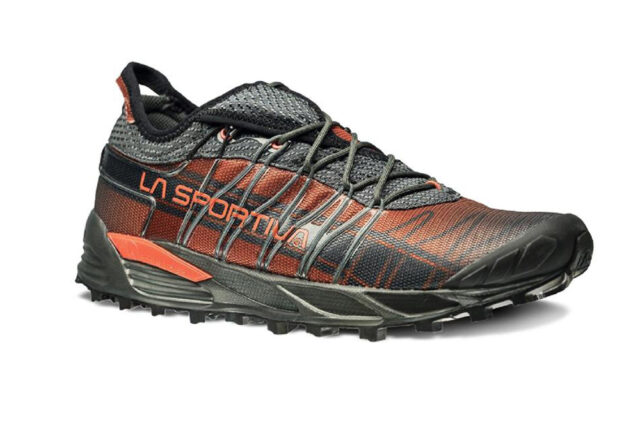
MSRP: $155
Size Tested: US Men’s 11 / EU 44.5
Reviewer: 5’11”, 165 lbs / 180 cm, 75 kg
Intro
Hailing from the Italian Dolomites, La Sportiva is largely known for making equipment suited for the most demanding and rugged mountain environments, and their running shoes are no exception. Many models within La Sportiva’s extensive lineup prioritize durability, protection, and all-terrain traction over speed, making them fan favorites of some of the hardiest and most daring mountain runners today.
The Mutant, one of La Sportiva’s longest-standing models, has been a popular option for technical terrain since its release. However, with its seemingly disparate collection of features, it can be a hard shoe to categorize. La Sportiva suggests it’s suitable for all types of surfaces and conditions, ranging from scree fields to buffed-out singletrack or wet / loose trails. That, to me, seems quite ambitious, if we’re being honest; a shoe with deep lugs, good ground feel, and good drainage — that’s also very protective, cushioned, and grippy — sounds slightly paradoxical. In this review, I’ll break down how the Mutant’s opposing features clash and complement one another to create a unique-feeling and versatile mountain running shoe, and then offer some thoughts on who I think should consider trying it.
Fit
Like many European footwear brands, La Sportiva has a reputation for making shoes that run on the narrow side. While my foot isn’t particularly bothered by a narrower last for runs up to the marathon distance (the Salomon Speedcross 5 is a model I reach for frequently), I do enjoy wider-platform shoes like Altra’s Lone Peak 6 from time to time. In my experience, the Mutant’s fit falls somewhere in between these two examples — it’s consistently medium-wide throughout the entire shoe. My forefoot enjoyed ample room in the toe box, without feeling like it was swimming around; however, the Mutant doesn’t taper all that much toward the rear of the shoe, which meant I often struggled to achieve the amount of heel lockdown I’m used to. This issue wasn’t made any easier by the Mutant’s thin and flexible heel collar, an area of the shoe that makes long-distance comfort a priority over a precise heel-hold for more technical moves.
The Mutant definitely prefers slightly wider feet than my scrawny talons, but narrowness notwithstanding, I actually ended up enjoying the shoe’s less precise fit, even in the most technical scenarios I found myself in. A huge reason why has to be because of La Sportiva’s “Spyraltongue” lacing system, which may be better described as a padded burrito-style tongue that works in conjunction with the Mutant’s asymmetrical, climbing-shoe-style laces. Together, these two parts quite effectively pull even tension across the laces, which distributes pressure from the midsole to the instep and allowed me to aggressively cinch down the Mutant, more than I would have been able to in shoes using traditional lacing systems. It did take me a few outings to adapt to this new (for me) style of fit, but once I did, the Mutant’s lacing system became a feature I really appreciated. I’ll touch on my experience running in the Mutant in more detail later in this review, but I think the shoe’s style of fit points precisely to how it should be used — i.e., for long-distance alpine running and scrambling.

Weight
Despite not having the highest stack height in La Sportiva’s lineup, the Mutant can sometimes feel bulky — our US Men’s Size 11 weighs 366 grams, which is pretty heavy for a trail running shoe with a fairly low stack height. I’d guess a lot of that weight can be attributed to the Mutant’s TPU stabilizing plate, extensive overlays included on the upper, and some pretty dense midsole foam. I definitely felt all 366 of those grams on the few shorter runs I took the shoe on, which were definitely slowed down a bit. However, on longer technical mountain runs, the Mutant’s heft never detracted from its performance. In fact, I think its extra weight equates to better stability and protection, two factors that often make the difference between a thrilling outing above treeline and a timid retreat back to the trailhead.
For reference, here’s how the Mutant’s weight compares to shoes with similar technical mountain running ambitions. All models are organized by their stated weight based on a US Men’s Size 9. It’s worth noting that companies’ measured weights are often understated, and I expect that to be the case with La Sportiva’s numbers here — the pair I tested is a significant 63 grams heavier than what’s listed on their website, much heavier than what is typically reasonable for a two-size discrepancy.
280 g / 9.8 oz — Dynafit Alpine
284 g / 10.0 oz — Topo Athletic Mtn Racer 2
292 g / 10.3 oz — Hoka Speedgoat 5
298 g / 10.5 oz — La Sportiva Bushido II
300 g / 10.6 oz — Scarpa Ribelle Run
300 g / 10.5 oz — La Sportiva Jackal
303 g / 10.7 oz — La Sportiva Mutant
311 g / 10.9 oz — Salomon X Alpine Pro
312 g / 11 oz — Nike Wildhorse 7
317 g / 11.2 oz — Adidas Terrex Agravic Pro
330 g / 11.6 oz — La Sportiva Cykclon
340 g / 12.0 oz — Salomon XA Pro 3D V8
Among this list of shoes, La Sportiva’s Mutant has one of the lowest stack heights but still sits in the middle of the weight spectrum. Make of that what you will, but in my opinion, focusing on grams when comparing shoes for rugged mountain running misses the point; improving line choice or becoming a more proficient climber will make much more of a difference in speed than an ounce or two on your feet. For those reasons, I think the Mutant’s weight is more than justifiable for a shoe that offers so much protection.
Upper
The Mutant’s upper is exactly what you’d expect from a shoe designed for long-distance runs across challenging terrain. It features an abundance of protective TPU overlays and a 4-way-stretch dynamic scree guard on top of La Sportiva’s proprietary “Air Mesh,” which is a fibrous layer of dense perforated nylon. Feature-laden uppers can often come at the expense of comfort and breathability, but I didn’t find that to be the case with the Mutant. While there are certainly more airy and forgiving uppers out there, my feet never felt sweatier than expected, especially in dry climates. La Sportiva’s tightly woven Air Mesh also provided just enough stretch to not feel overly restrictive.
I’ve already spoken about how La Sportiva’s Spyraltongue structure and thin, flexible heel collar affect the Mutant’s fit, but I think it’s worth touching on the impact these design features have on the shoe’s performance, too. Both are derived from rock climbing shoes, which prioritize an extremely precise fit to facilitate a full range of motion in the ankle / foot while minimizing slop / slippage, for maximum purchase on rock. These attributes translate to the Mutant; I’ve been able to lace this shoe tighter than most of my trail running shoes, giving me confidence on nearly every type of running surface, while still maintaining blood flow to my feet. Its burrito-style lacing system also allows the Mutant to do away with the large and often-uncomfortable heel collar commonly used in trail shoes to aggressively lock down the foot. Instead, we get one that’s thin and pliant, which has been much more comfortable when the miles start to really pile up.
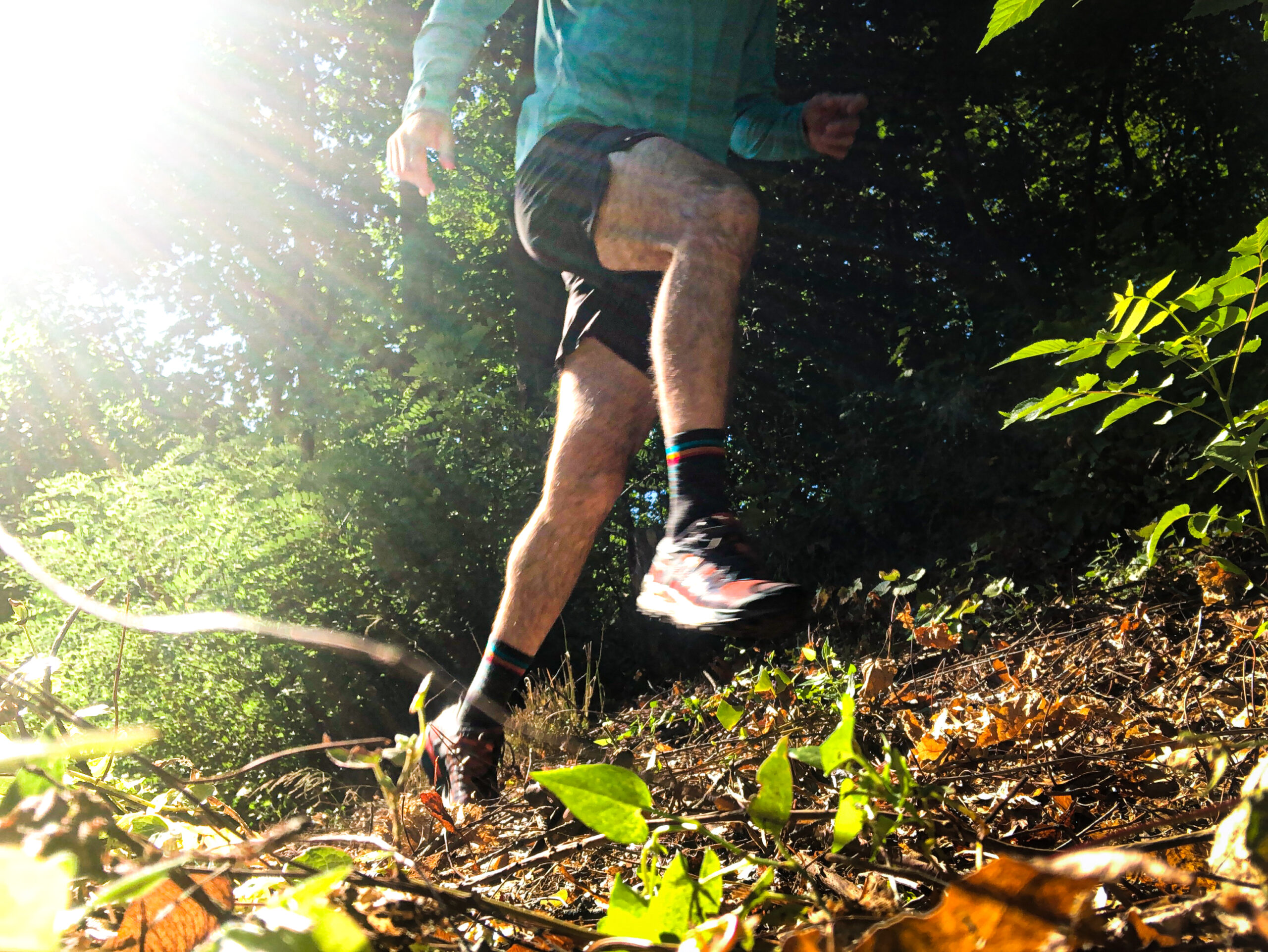
It’s actually rained a fair bit in my part of Colorado this summer, and while I’d much prefer clear skies for days above treeline, the frequent downpours have allowed me to test out the Mutant in wet conditions. So far, what’s impressed me the most is how quickly the shoe’s upper drains. I not only noticed the Mutant’s fast-drying properties when caught in a storm, but also during early morning runs spent bushwhacking through dewy roughage and stream crossings.
While I’ve heaped praise on the Mutant’s upper, I do think it deserves a bit of criticism for its durability, or lack thereof. An argument can be made that there’s simply just too much going on; the combination of stiff plastic overlays with softer, stretchier nylon mesh seems to create some problems. The materials are not bonded together strongly enough and I’m seeing quite a bit of delimitation at the shoe’s flex points after just the first 80 miles. While this hasn’t sabotaged the Mutant’s performance yet, it’s something I’ll be monitoring closely.
Midsole
Continuing with the theme of ostensibly contrasting designs we’ve traced through the Mutant, its midsole is not without its own set of eccentricities. Don’t read that as a pejorative though, because after testing, I think the shoe’s combination of injection-molded EVA and a TPU stabilizer makes for one of the most interesting midsoles I’ve run in to date.
I made a conscious effort to enter my testing period with the Mutant completely blind, with a perspective not biased by other reviews or even stated specifications of the shoe. Out of the box and after a handful of runs, I figured it was a fairly high-cushioned shoe based on how well it handled downhills. I don’t think I’ve ever been more confident running fast down technical and chunky trail (except maybe as a reckless teenager…). Needless to say, my mind was a little blown when I learned the Mutant actually has a stack height below 30 mm, at only 24 mm / 14 mm. My feet tend to fatigue in shoes with cushioning that low after about 10 miles on rough trail, and I generally have to pay more meticulous attention to foot placement so as to avoid sharp / unstable rocks. However, the Mutant’s protection and cushioning have allowed me to be a little less precise with where I’m landing, setting my mind free to enjoy the fast and fluid strides.
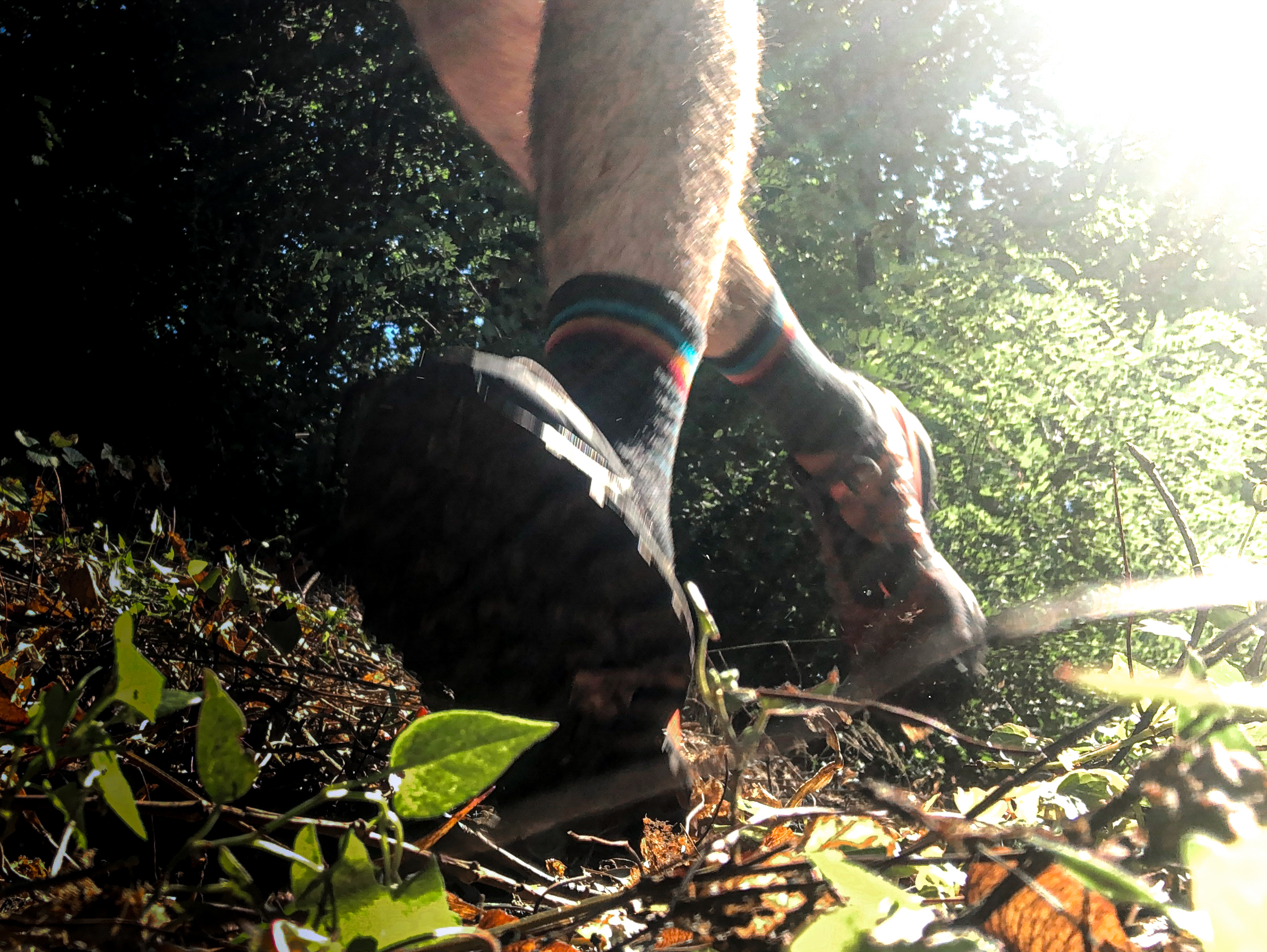
But the success of the Mutant’s midsole can’t just be explained by stack height; it’s the feel the midsole lends the shoe that puts it in contention for one of my all-time favorites. La Sportiva’s blend of EVA foam makes for a pretty plush ride, and when paired with the Mutant’s TPU stabilizer, the combination provides stability and rebound in the midfoot and heel without taking away from ground feel and flexibility in the forefoot. The result is a shoe that I have felt quite balanced in, especially on aggressive downhill sections of trail (though I will add the Mutant’s midsole took me about 15 miles to break in; it felt pretty stiff at first, which made the shoe feel tippy, but that faded quickly into the blend of stability and cushioning I’ve praised throughout this review).
Despite an incredibly effective midsole that manages to feel simultaneously like that of a quite maximal trail shoe and one taken from a model designed for skyrunning, ignoring the Mutant’s imposing heel-to-toe drop would be an oversight. At 10 mm, it’s a design decision that leaves me a bit confused. While higher drops in shoes (e.g., between 8 mm and 12 mm) can alleviate stress on the Achilles tendon when logging a ton of steep vert, they often just relocate that stress to the forefoot and knee when on flat and/or downhill terrain. I would have expected La Sportiva to anticipate these different loading patterns and have given the Mutant a bit lower of a drop, or at the very least reinforce its forefoot with more padding. In my case, I’ve had to spend extra time stretching the muscles around my knees and caring for my arthritic big toes (hallux limitus) because of the shoe’s steep geometry (more on that below). My own ailments aside, it wouldn’t surprise me if the Mutant forced runners to adopt more of a midfoot / heel strike than they’re used to.
All in all though, the Mutant has flown up the ranks as my all-time favorite trail shoe for bombing technical downhills. What’s more, it manages to do that while also feeling plush and reactive on flatter terrain, too.
Outsole
On my first run in the Mutant, I faced a long section of fairly steep, off-camber slickrock, the first real test for the shoe. As I slithered my way across, it became obvious to me how the Mutant got its name — not only did the outsole provide exceptional traction, but the deep lugs made popping sounds like an octopus’s suction cups feeling their way over a victim as they clung to the granite. It was both dramatic and… oddly satisfying.
I hope that little vignette gets my point across: La Sportiva’s “FriXion White” rubber, their tackiest compound, grips rock superbly, and the Mutant’s 6 mm, widely-spaced, multi-directional lugs supplement already phenomenal traction by articulating incredibly well. The shoe’s outsole should provide confidence on all sorts of rock, and it maintains traction on soft ground almost as well as a dedicated mud shoe. This is coming from someone who normally likes a tighter / shallower lug pattern for more consistent traction on rock, but the performance of the Mutant’s deep lugs has been superior across many conditions, including my numerous rainy outings.
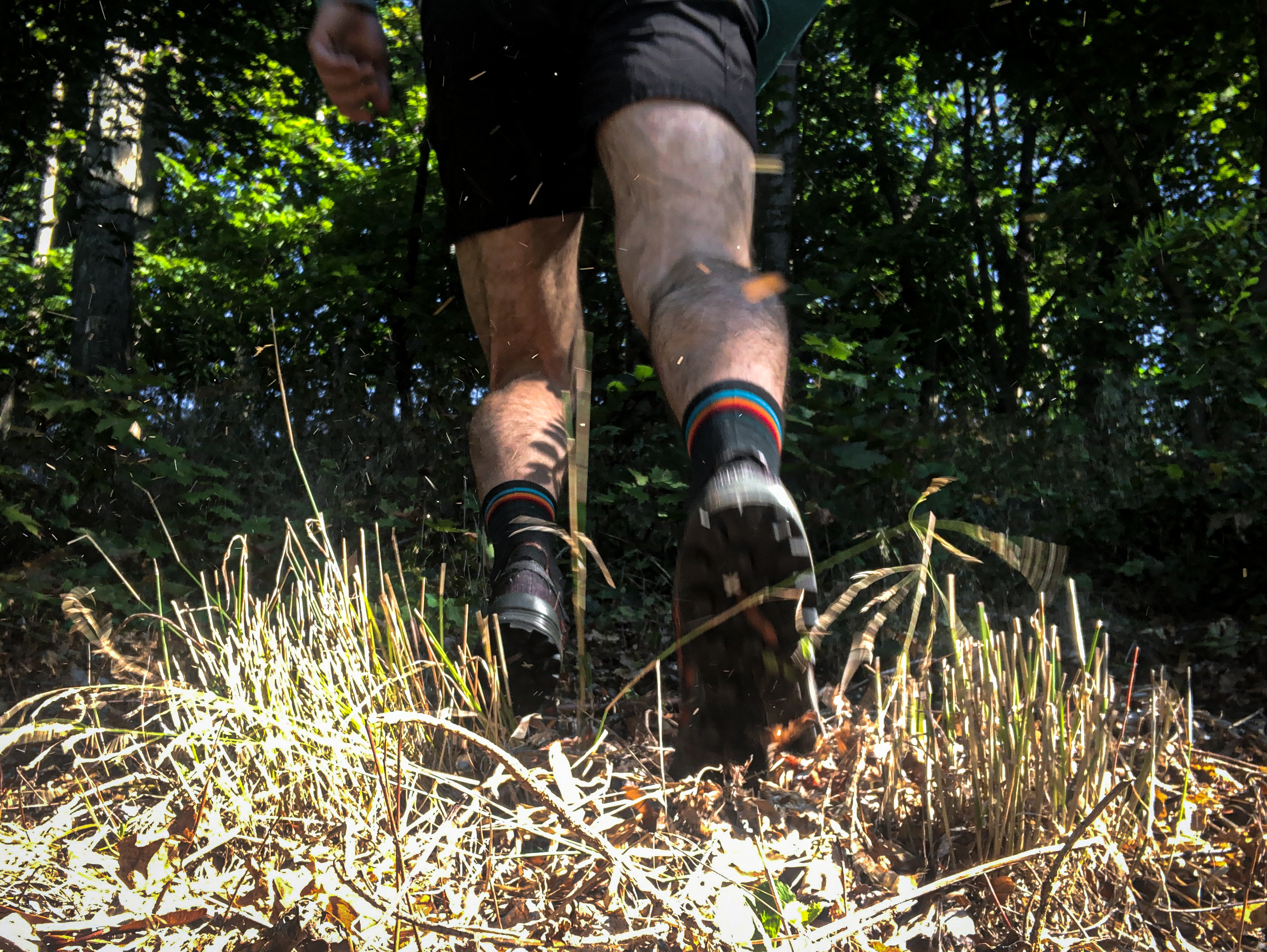
On Trail
The Mutant has long been a shoe I’ve been curious about, and the prospect of reviewing a pair excited me. It’s a legacy model championed by many mountain running visionaries, crafted with the technical running / lightweight mountaineering I love in mind. In those environments, the Mutant did not disappoint. The shoe performed with impressive versatility, offering rebound on flat hard-packed stretches of trail, stable traction on a wide variety of off-camber surfaces, and cushy roll on scrappy downhills. I often found myself thinking, “I need to stash a pair or two of these shoes away for when La Sportiva inevitably updates (and ruins) them.” And while not exactly inspiring great speed, the Mutant did shepherd me into spending longer and more challenging days in the mountains. That’s a win in my book.
Unfortunately, all of those high-flying feelings came at the expense of my metatarsals, which felt gnawed away at and painful after longer outings. Not since naively running in street sneakers in my youth have I felt such discomfort. Some of my trouble is certainly subjective and likely has a lot to do with the inflexibility of my toes, but I think it’s worth sharing because I suspect folks with sensitive feet will also probably have a hard time adapting to the Mutant’s soft forefoot and high drop. For those reasons, it will be a shoe I reach for in the future only when I’m sky-running or peak-bagging.
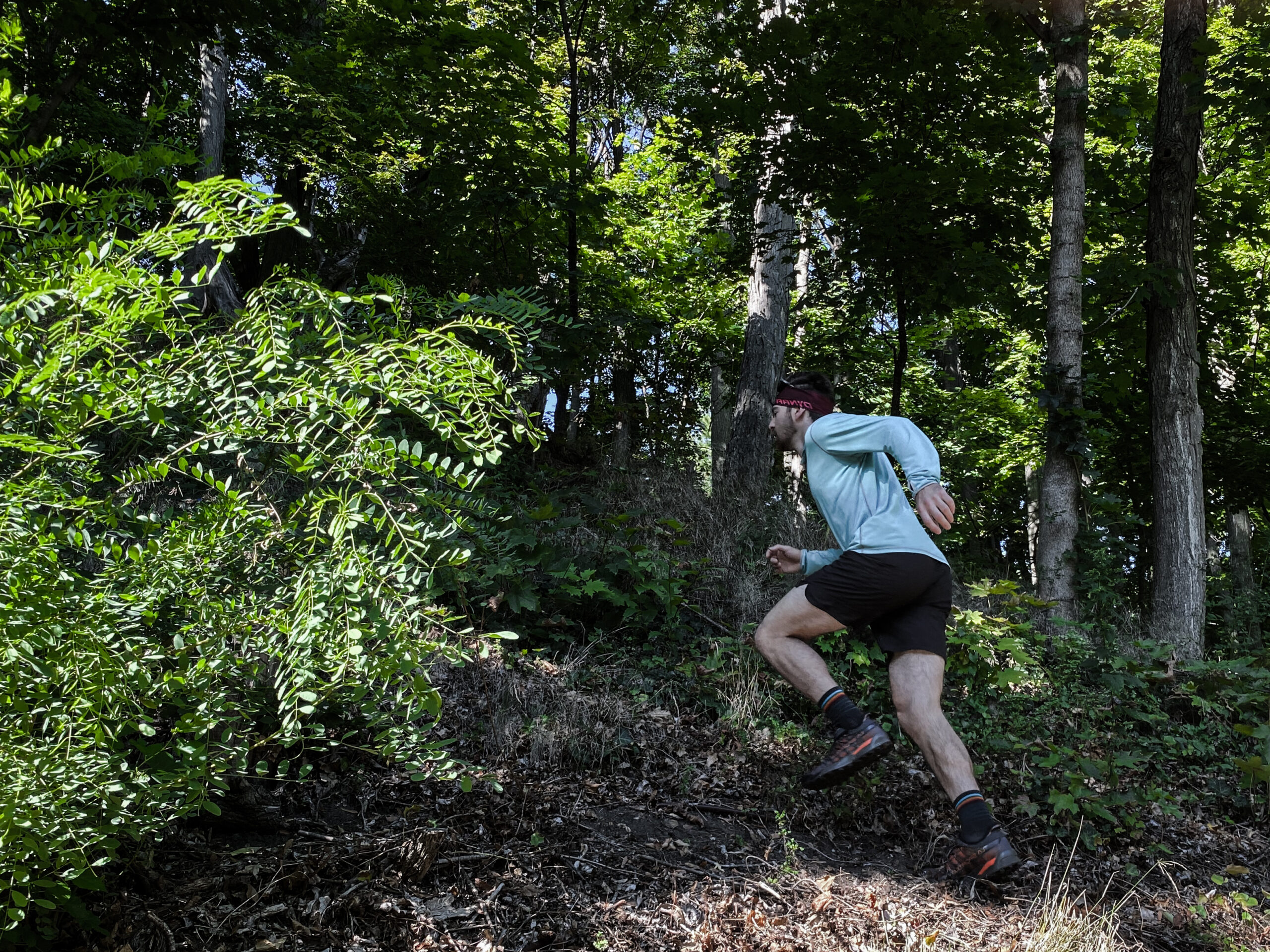
Durability
I’ve already rebuked the Mutant for how quickly its outsole began to deteriorate (though I suspect faulty manufacturing may be at blame), but to my list of quibbles I will add tearing heel tabs and the numerous points of peeling plastic overlays across the shoe’s upper. These failures are so at odds with La Sportiva’s reputation, I’m wary of making blanket statements like, “these shoes don’t last!” Instead, I’ll give La Sportiva the benefit of the doubt and guess that the pair I received had been stored improperly or suffered from some manufacturing error. Aside from splitting seams, the shoe’s raw materials have held up well; the Mutant’s Air Mesh upper has survived abrasive bushwhacking and scrambling, and the injection molded EVA midsole has retained the balanced feel it settled into once broken in. The Mutant’s potential has left me with fingers crossed that I received a defective pair, because a more durable version of the shoe I received would likely be a fixture in my rotation.
Who’s It For?
The Mutant is not one of those shoes that straddles the line between categories. After nearly 100 miles, the use case for my pair has remained unchanged; in my opinion, it’s a model best suited for alpine adventure runs — slower-paced, long days with high stakes in rough terrain. A potential match for this shoe would be a runner who prioritizes traction on rock, good ground feel, and a lot of protection and stability. However, this hypothetical runner should be mindful of the Mutant’s high drop before buying a pair. People with a history of forefoot issues may want to limit their time in the Mutant or stay away from it entirely. That said, if this style of shoe interests you, it’s worth trying on in person if you can. While its ideal use case is fairly narrow, it’s really, really good at what it’s supposed to do.
Bottom Line
La Sportiva nailed the name of this shoe. The Mutant is for getting freaky in the mountains; just look at the stuff Anton Krupicka and Justin Simoni do with it. “Mutant” also suggests superhero-esque mutation, and that (abstractly) points to exactly what I think this shoe does so well. It has a plush feel reminiscent of shoes with thicker midsoles and performs nearly as well on soft surfaces as some mud shoes. However, staying true to La Sportiva’s ethos, the Mutant really shines on rock. It’s a shoe that happily takes on the variability of alpine environments and makes downhill running a blast. If you’re looking to enjoy your long days picking through rock and tundra in the mountains, go try on a pair of Mutants.

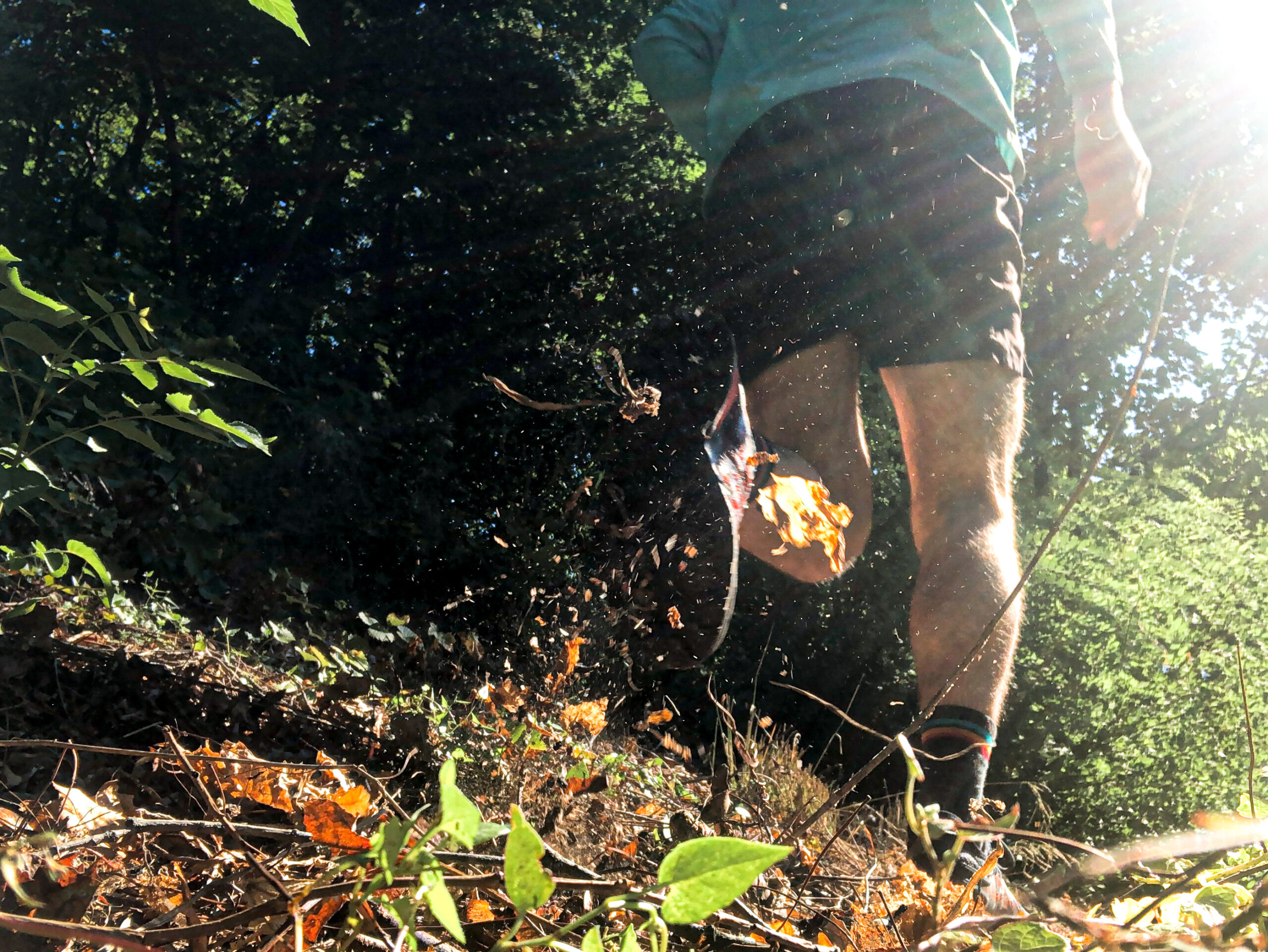


Appreciate the in-depth review Drew! I was also struck by the comfort in comparison to the relatively low stack height (I’m used to running in Speedgoats). Definitely one of my favorites shoes for technical scrambles on ridge lines with long runnable approaches. My only issue (other than the 10mm drop….) is also related to durability as the laces have nearly broken at the tightening points of the eyelets after less than 30 miles. Curious if you had a similar experience or if I’m just over tightening them. Thanks!
Hey Peter,
I haven’t had durability issues with the laces on my pair, but I have heard of the laces snapping occasionally right out of the box from a few people I know who run in them…And no, I don’t think you’re tightening them too much, as long as they’re still comfortable of course—no one wants a loose shoe on a ridgeline scramble or trail run approach!
Very strange. I disagree fundamentally having spent a lot of time in the shoe. It is the least inspiring shoe on rock I’ve ever been in. the squishiness of the knobs really deteriorate the performance. Not only do you lose rubber quickly, but the squirminess is very noticable-particularly on rock. It’s not a responsive shoe because you have to squirm through the knobs to feel what’s going on. I hate it for scrambling for that very reason. Try edging with it, it’s laughable, tho it does ok smearing just due to the rubber. The heel to toe drop is also eggregious tho may work for some. I do like the overlap lacing design which I find is comfortable but I also have got Achilles digging from the rear. The mutant to me is the most over hyped and underdelivering shoe and has been for years-mainly due to antons IG. It’s a mutant for sure, of the worst kind-it manages to suck at everything. Too squishy and clunky to be responsive. Too much heel to toe for natural gait and feel. Terrible at descending unless you like smashing with your heels (not something I do in rocky terrain) the heels also so elevated it feels clunky and disconnected from the terrain. I remember switching to the speedgoat and setting large PRs on every descent. The speedgoat is way better for grippy running and despite being monstrously huge feels responsive and natural and the dynafit feline up pro is way better for shorter distances and actual climbing. All in all, I couldn’t recommend the mutant to anyone, for any purpose frankly. It’s almost better as a hiking shoe than something for running. Harder rubber with less tall knobs and smaller drop would go a long way in this shoe. I’ve also had durability issues with it.
Hey Anthony,
Thanks for reading and commenting! I’d like to address your points:
Usually I’d agree that the tall lugs/knobs would feel squirmy. But in the Mutant’s case, though they are tall, they have a lot of surface area. And because the rubber trends towards stickiness as opposed to longevity/firmness (in my experience many taller-lugged/mud shoes have more rigid lugs than the Mutant), I felt more like they were articulating more than “squirming,” a feeling I know from other shoes. But yes, as I mentioned in the article, the Mutant does lose rubber quickly.
I haven’t done much edging on the scrambles I’ve been on in the Mutant yet, but have climbed in the 5.4ish range with them, and at those low fifth class grades I thought the shoe performed really well, especially smearing (as you note), even though the outsole looks like the antithesis of a true climbing shoe’s sole, or even many other rock oriented shoes’, which often have flat “climbing zones” in their tread patterns, a thicker heel collar, lower stack height and drop, and overall lower volume. But I would be suspicious of the Mutant’s performance on thinner edging-style moves—there just isn’t a ton of that where I usually am running/scrambling in the Crested Butte area.
As I mentioned in the review, the high drop didn’t work for me either, and actually left me a bit puzzled. So I agree with you, and I’d be curious to run in a version of this shoe with a lower drop. But the flexible and thin heel collar didn’t bother my achilles, which often gets aggravated by more rigid heel collars, especial ones with big pillows. I thought the design of the Mutant’s heel collar not only worked well for me (which is almost irrelevant to the larger point), but aligns well the intended/best use of the shoe.
And to speak to your comment about the Mutant underdelivering/not being good at much: my interpretation of the shoe is that it was designed to do well in a variety of rugged alpine and sub-alpine terrain over long distances. By designing a shoe meant for disparate scenarios, there will always be compromise, which can mean that when you take the shoe out of those intended scenarios those compromises can sometimes be exacerbated. So sure, it may not be amazing at any one thing, but I still think it does a few things pretty well, which when brought together over the course a single diverse run, make for pretty effective shoe.
To me, this shoe doesn’t need to be responsive or fast-feeling when running; the terrain it’s built for is not necessarily conducive to that type of running (techy/rugged trail will inherently be run at a slower pace than buffed out trail—it just demands much more attention). For this type of running, I think the shoe needs to be stable and protective, and comfortable, all of which it was for me—and I’m saying that in comparison to many comparable shoes I’ve used.
Yes, it does favor heel strike on the descent due to the huge drop, which is not something I prefer either—but as far as heel strikes go, it was quite comfortable, stable, and rolled well through the foot, which enabled me to run pretty extended steep downhill sections more comfortably and quickly than a nearly every other shoe I’ve worn has.
But all that is just my experience relative to other shoes I’ve done similar style runs and scrambles in.
Unfortunately I can’t speak to the Speedgoat comparison…I’d be curious to hear more about the runs you’ve done in the Mutant.
Cheers!
Thx for the thoughts. Seems we mostly agree on specifics, just have differing overall views. I’ve had several pairs of mutants over hundreds of miles. I live up in the pnw doing runs like the enchantments, alpine stuff like west McMillan spire and west ridge of forbidden amongst other local unnamed scrambles and general vertical based running. On big days I prefer responsiveness in technical terrain, mainly cause big clunky shoe like the mutant are easier to roll an ankle when hopping scree and pokey angulated rock and such. Cushion and support for me are ideal in non technical environments where foot placement is of much less concern than a 20 miler with 10k of vert and technical rock. These days I’m running far less than I used to and biking more. Different strokes for different folks. They work for anton, but I also know he removed the original outsole and put on dot tread rubber for actual scrambling. I would also say that something working for a pro isn’t a good qualifier which I why I think there are better shoes for any purpose
Great point, Anton—just because a pro “likes” them (there is all sorts of bias implicit in them claiming publicly they like a product), doesn’t mean they’re the best option out there.
And coincidentally, a friend gave me their unused pair of Speedgoat 5 right after you and another commenter mentioned it, and to me, so far (I’ve got less than 50 miles in them), it feels like a shoe designed for very different purposes, and one that I personally don’t think I would use for anything resembling the type of mountain running/scrambling combos I used the Mutant for. But, a full review is in the works, so I’ll be paying attention to how my impression of that shoe shifts over time. Again, to your other good point, different strokes for different folks.
Best!
I found this review very interesting thanks. I’m a runner not a writer, so hearing them described eloquently and accurately is fascinating, as I know these shoes well! I’m on my third pair of Mutants over about 7 years. I first happened across them in a mountaineering shop in North Wales (UK) and immediately thought “where have you been all my life?”. The combination of flexible, comfortable upper, great lacing and well cushioned, grippy lower appealed very strongly. I still remember the day!
Perfect for running a few miles on road to get to trail, then enjoying a shoe which can go wherever the mood, and opportunity, takes me. Mud, rock, trail, sand, snow – my Mutants have done it all! I’ve tried others but I keep coming back to these. I love them!
They’re not perfect; they tend to be brutal on my feet for the first 30 miles or so (maybe I should size up) but then they become a part of me.
I agree with the laces comment above; all of mine have frayed although not yet snapped. Each of my pairs of shoes has “died” where the upper toe section fabric meets the rubber toe cap. After a few hundred miles (when the grips are half worn and and there’s plenty of life left in the cushioning) the fabric tears at the join (although the inner sock is in tact). Disappointing and frustrating – although it doesn’t seem to really affect the performance.
I get on really well with the drop. Other, flatter shoes don’t suit my heel striking style and are slower. In those I slap – in Mutants I speed! I have turned an ankle in them though…that heel is a long way down!
I actually keep my old pairs and have been known to bring them out of retirement when the “current” pair gets even more worn than an old pair.
I guess if they sorted the above toe box wear issue out, supplied tougher laces and a harder wearing outsole they could be perfect…but maybe they’d lose something of their fit and versatility.
A unique and passionately engaging shoe for sure!
Spot on review ! I live in Hawaii and put 100’s of miles in my Mutants . They are the PERFECT trail shoe for Hawaii . I beat the heck out of them since them off ,. dry them out ,. slap them on and go,…. and Repeat :) I cant not wait for the new colors to come out this summer ! The Mutants are the sheeeeeeeeeee it.
Great Review!
Everything looks great about this shoe as far as what I am looking for. I tend to overpronated…would this shoes provide a bit of medial support to slow the rate of pronation for me? I also need a shoe with a more supportive upper. For example, even though the Asics GT 2000 series have good mid soles for support, I find the upper is so thin for breathability and weight that support on a trial is compromised. How would these compare to Asics gel GT 2000 in that regard? For example I have been running in Asics discontinued Gel Kahana 8 which provide much more stability/structure in the upper than the GT 2000 trail.
Thanks!
At 6’1″ and 210, the mutant is perfect. It has the stability and traction much needed for technical adventures. I love the 10 mm drop on steep climbs and decent. Its great for 25k and possibly more. Great in mud and sticky on rocks.
Great review and Thanks!